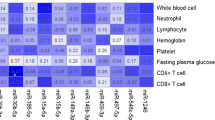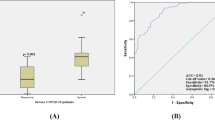Abstract
Coronavirus disease 2019 (COVID-19), a serious infectious disease caused by the recently discovered severe acute respiratory syndrome coronavirus 2 (SARS-CoV-2), has caused a major global health crisis. Although no specific antiviral drugs have been proven to be fully effective against COVID-19, remdesivir (GS-5734), a nucleoside analogue prodrug, has shown beneficial effects when used to treat severe hospitalized COVID-19 cases. The molecular mechanism underlying this beneficial therapeutic effect is still vaguely understood. In this study, we assessed the effect of remdesivir treatment on the pattern of circulating miRNAs in the plasma of COVID-19 patients, which was analyzed using MiRCURY LNA miRNA miRNome qPCR Panels and confirmed by quantitative real-time RT-PCR (qRT-PCR). The results revealed that remdesivir treatment can restore the levels of miRNAs that are upregulated in COVID-19 patients to the range observed in healthy subjects. Bioinformatics analysis revealed that these miRNAs are involved in diverse biological processes, including the transforming growth factor beta (TGF-β), hippo, P53, mucin-type O-glycan biosynthesis, and glycosaminoglycan biosynthesis signaling pathways. On the other hand, three miRNAs (hsa-miR-7-5p, hsa-miR-10b-5p, and hsa-miR-130b-3p) were found to be upregulated in patients receiving remdesivir treatment and in patients who experienced natural remission. These upregulated miRNAs could serve as biomarkers of COVID-19 remission. This study highlights that the therapeutic potential of remdesivir involves alteration of certain miRNA-regulated biological processes. Targeting of these miRNAs should therefore be considered for future COVID-19 treatment strategies.


Similar content being viewed by others
Data availability
The data that support the findings of this study are available from the corresponding author upon reasonable request.
References
Hu B, Guo H, Zhou P, Shi ZL (2021) Characteristics of SARS-CoV-2 and COVID-19. Nat Rev Microbiol 19:141–154. https://doi.org/10.1038/s41579-020-00459-7
Mason RJ (2020) Pathogenesis of COVID-19 from a cell biology perspective. Eur Respir J. https://doi.org/10.1183/13993003.00607-2020
Hendaus MA (2021) Remdesivir in the treatment of coronavirus disease 2019 (COVID-19): a simplified summary. J Biomol Struct Dyn 39:3787–3792. https://doi.org/10.1080/07391102.2020.1767691
Bartel DP (2004) MicroRNAs: genomics, biogenesis, mechanism, and function. Cell 116:281–297
Kreth S, Hübner M, Hinske LC (2018) MicroRNAs as clinical biomarkers and therapeutic tools in perioperative medicine. Anesth Analg 126:670–681. https://doi.org/10.1213/ANE.0000000000002444
González Plaza JJ (2016) Current roles of microRNAs in infectious diseases—advancing into healthcare. Infektološki glasnik 36:5–15
Fayyad-Kazan M, ElDirani R, Hamade E et al (2019) Circulating miR-29c, miR-30c, miR-193a-5p and miR-885-5p: Novel potential biomarkers for HTLV-1 infection diagnosis. Infect Genet Evol 74:103938. https://doi.org/10.1016/j.meegid.2019.103938
Schmittgen TD, Livak KJ (2008) Analyzing real-time PCR data by the comparative C(T) method. Nat Protoc 3:1101–1108
Hardin LT, Xiao N (2022) miRNAs: the key regulator of COVID-19 disease. Int J Cell Biol. https://doi.org/10.1155/2022/1645366
Li C, Hu X, Li L, Li J, hui, (2020) Differential microRNA expression in the peripheral blood from human patients with COVID-19. J Clin Lab Anal. https://doi.org/10.1002/jcla.23590
Fayyad-Kazan M, Makki R, Skafi N et al (2021) Circulating miRNAs: potential diagnostic role for coronavirus disease 2019 (COVID-19). Infect Genet Evol. https://doi.org/10.1016/J.MEEGID.2021.105020
Farr RJ, Rootes CL, Rowntree LC et al (2021) Altered microRNA expression in COVID-19 patients enables identification of SARS-CoV-2 infection. PLoS Pathog 17:e1009759. https://doi.org/10.1371/JOURNAL.PPAT.1009759
Giannella A, Riccetti S, Sinigaglia A et al (2022) Circulating microRNA signatures associated with disease severity and outcome in COVID-19 patients. Front Immunol 13:4409. https://doi.org/10.3389/FIMMU.2022.968991/BIBTEX
Panda M, Kalita E, Singh S et al (2022) MiRNA-SARS-CoV-2 dialogue and prospective anti-COVID-19 therapies. Life Sci 305:120761. https://doi.org/10.1016/J.LFS.2022.120761
Aschner Y, Downey GP (2016) Transforming growth factor-B: master regulator of the respiratory system in health and disease. Am J Respir Cell Mol Biol 54:647–655
Wang S, Zhou L, Ling L et al (2020) The crosstalk between Hippo-YAP pathway and innate immunity. Front Immunol 0:323. https://doi.org/10.3389/FIMMU.2020.00323
Ma-Lauer Y, Carbajo-Lozoya J, Hein MY et al (2016) P53 down-regulates SARS coronavirus replication and is targeted by the SARS-unique domain and PLpro via E3 ubiquitin ligase RCHY1. Proc Natl Acad Sci USA 113:E5192–E5201. https://doi.org/10.1073/PNAS.1603435113/SUPPL_FILE/PNAS.201603435SI.PDF
Wardzala CL, Wood AM, Belnap DM, Kramer JR (2022) Mucins inhibit coronavirus infection in a glycan-dependent manner. ACS Cent Sci 8:351–360. https://doi.org/10.1021/ACSCENTSCI.1C01369/ASSET/IMAGES/LARGE/OC1C01369_0005.JPEG
Kwon PS, Oh H, Kwon SJ et al (2020) Sulfated polysaccharides effectively inhibit SARS-CoV-2 in vitro. Cell Discov 6:1–4. https://doi.org/10.1038/s41421-020-00192-8
Fleseriu M (2021) Pituitary disorders and COVID-19, reimagining care: the pandemic a year and counting. Front Endocrinol (Lausanne) 12:200. https://doi.org/10.3389/FENDO.2021.656025/BIBTEX
Diallo I, Jacob RA, Vion E et al (2023) Altered microRNA transcriptome in cultured human airway cells upon infection with SARS-CoV-2. Viruses 15:496. https://doi.org/10.3390/V15020496/S1
Diallo I, Ho J, Laffont B et al (2021) Altered microRNA transcriptome in cultured human liver cells upon infection with Ebola virus. Int J Mol Sci. https://doi.org/10.3390/IJMS22073792
Funding
This work was supported by the Lebanese University.
Author information
Authors and Affiliations
Corresponding authors
Ethics declarations
Conflict of interest
The authors declare that they have no conflict of interest.
Ethical approval
All procedures involving human participants were in accordance with the ethical standards of the local ethics committee of the Lebanese University and with the 1964 Helsinki declaration and its later amendments.
Informed consent
Informed consent was obtained from all individual participants included in the study.
Additional information
Handling Editor: William G Dundon.
Publisher's Note
Springer Nature remains neutral with regard to jurisdictional claims in published maps and institutional affiliations.
Rights and permissions
Springer Nature or its licensor (e.g. a society or other partner) holds exclusive rights to this article under a publishing agreement with the author(s) or other rightsholder(s); author self-archiving of the accepted manuscript version of this article is solely governed by the terms of such publishing agreement and applicable law.
About this article
Cite this article
Fayyad-Kazan, M., Makki, R., Homsi, M.E. et al. Circulating microRNA profile in response to remdesivir treatment in coronavirus disease 2019 (COVID-19) patients. Arch Virol 168, 194 (2023). https://doi.org/10.1007/s00705-023-05825-3
Received:
Accepted:
Published:
DOI: https://doi.org/10.1007/s00705-023-05825-3




